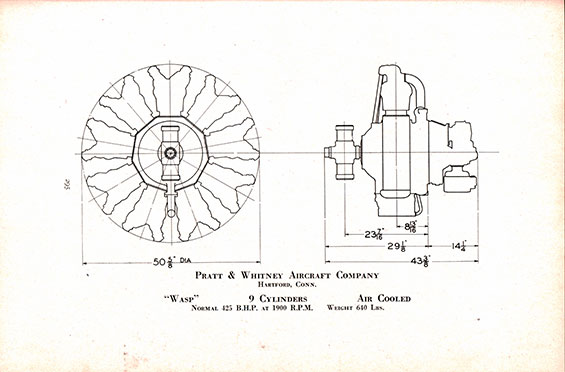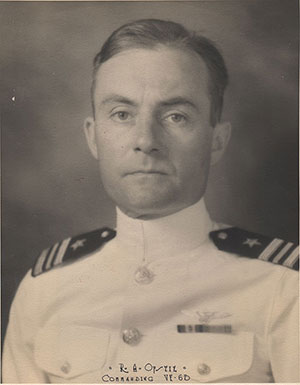|
Ralph Ofstie was an accomplished aviator for the U.S. Navy. He was born November 16, 1897 at Eau Claire, WI. He died November 18, 1956 at Bethesda, MD and is buried, along with his wife, at Arlington National Cemetery. His experience in naval aviation spanned from fabric-covered aircraft with radial engines to jet aircraft and guided missles. A news article, below, courtesy of fultonhistory.com (FH), detailed the latter a few years before his death.
Buffalo News-Express, June 20, 1953 (Source: FH)
 |
The 1910 U.S. Census places Ofstie, 12, living with his family in Eau Claire at 328 Broadway Street [sic]. He lived with his father and mother and four siblings, sisters Elsie, Astrid and Vallborg, and a brother, Harold.
Ofstie graduated from the U.S. Naval Academy in 1918 and was assigned to destroyers. He was part of the U.S. Expeditionary Force sent to Europe during WWI. A ship's register for August 11, 1918 lists him as one of 26 naval officers landing that day.
Interestingly, the 1920 U.S. Census, tabulated January 30th, places Ofstie aboard the destroyer U.S.S. O'Bannon, among his other shipmates, who are all listed. He was 22 years old, and his occupation was listed as "officer." After his destroyer experience, he was assigned to flight school at Pensacola, FL. On June 8, 1922 he became a Naval Aviator #3010.
Numerous online resources document his Navy life and assignments. A short biography with a photograph and career summary is at the link. A summary of his honors and medals is at the link. He appears to have served in a good balance of roles, on and off shipboard, from flight operations to executive roles in Washington, DC (Bureau of Aeroautics) and London, England. He moved forward in the naval ranks at a normal rate, holding the rank of Lieutenant when he visited Tucson.
Ofstie landed once at Tucson, Sunday, October 10, 1926 at 11:45AM. He was solo in an unidentified Curtiss F-6C-4. Based at Washington, DC, Anacostia, he arrived at Tucson westbound from El Paso, TX. He remained on the ground an hour and a half before departing to San Diego, CA.
His flight was significant. His travel through Tucson had begun earlier in October in Hartford, CT, home of Pratt & Whitney Aircraft Corporation (P&W) which manufactured the newly developed P&W 425HP "Wasp" engine (schematic, below). This REFERENCE states, on page 50,
Ofstie Transcontinental Flight, October 1926 (Source: P&W Reference)
"Lieutenant (later Rear Admiral) Ralph Oftsie [sic], of the Bureau of Aeronautics, was assigned to fly the Wasp-powered Curtiss Hawk (F6C-4) to San Diego where Rear Admiral Joseph N, Reeves had gathered all the Navy's aircraft battle squadrons and crack pilots to explore new tactics. Oftsie flew to Hartford for a final check on his Wasp, which already had 85 hours of flight time, and then set out from Washington on October 6 for San Diego by way of Dayton, Dallas and the Mexican border [which included nearby Tucson]. Pratt & Whitney Aircraft had stationed service representatives at several of the fueling points with kits of tools and spare parts in case he encontered engine trouble. None of them worked a moment on the engine. He arrived at the San Diego air base on North Island on October 10.... After several weeks of test flying by the battle fleet pilots, Oftsie [still sic] flew to Seattle and then returned to Washington via the air-mail route through Salt Lake City.
"The official Navy statement of Oftsie's flight noted:
'The new Pratt & Whitney engine proved to be remarkably satisfactory for this service from the time of leaving Washington until return. The engine had about 75 flying hours and the only work done was removal and inspection of spark plugs at San Diego. Nothing else was required beyond filling the fuel tanks and cranking up the engine" |
The following P&W Wasp engine schematic is from the 1927 Aircraft Yearbook. For another example of the use of the new P&W Wasp, please see Ford NX6926.
Schematic Drawing of the Pratt & Whitney "Wasp" Engine (Source: Link)
 |
Continuing, a few years later, the 1930 U.S. Census placed him at 2701 Connecticut Avenue, Washington, DC in a $75/month rented apartment. He was identified as an "Officer, Navy." Curiously, he did not have a radio set in his apartment.
R.A. Ofstie, Ca. 1934 (Source: Choureé Collection)
 |
The portrait, right, comes from a scrapbook assembled by Register pilot Emile Choureé for the 1934 National Air Races (NAR). Ofstie was the commander of the Navy performance squadron at the Races that year, and Choureé was the field and on-air broadcaster for the Navy performances. Choureé's complete scrapbook can be downloaded at the link for your enjoyment (scroll down the page to the 1934 NAR and download the scrapbook). Ofstie's NAR orders, and the 1934 Navy squadron he led, are also pictured at the link. He holds the rank of Lt. Commander in this photograph. The 1934 NAR and Ofstie's role were summarized in The New York Times, September 3, 1934.
R.A. Ofstie Obituary, November 19, 1956, Washington Star (Source: NASM)
 |
Ofstie set some of the early records for naval aircraft. For example, from this REFERENCE, June 13, 1923, page 55, we find Ofstie setting speed records of 121.95 and 121.14MPH for Class C seaplanes equipped with a Lawrance J-1 engine.
The same reference, page 58, describes another set of records made the following year. On October 25, 1924, "Lt. R.A. Ofstie, in a CR-3 with a Curtiss D-12 engine, broke world speed records for 100, 200, and 500 kilometers with marks of 178.25 m.p.h., for the 100 and 200, and 161.14 for the 500." That he maintained the same speed for the 100 and 200 kilometer distances is testimony to the precision of his flying. These records were set after the Schneider Cup Race was cancelled for the year. Documentation of the race appeared in The New York Times of October 26, 1924. Besides this article, Ofstie was the subject of tens of Times articles over the next forty years. Their subjects included his naval assignments, activities during WWII and the Korean conflict, and his role at the 1934 NAR (see above citation).
Results in 1925 were different. The same reference, page 61 for October 26, 1925 states, "The two Navy entries in the Schneider Cup Race at Bay Shore Park, Md., flown by Lts. George Cuddihy and Ralph A. Ofstie, were forced out of the race on the last lap with engine trouble. A description of the Schneider races and airplanes is at the link. And 1926 involved some excitment, too, as documented in the brief article below from the Bureau of Aeronautics Newsletter for September 25, 1926.
Bureau of Aeronautics Newsletter, September 25, 1926
(Source: Webmaster)
 |
Later in his career, during WWII as a Rear Admiral (rank earned in August, 1944), Ofstie led a Task Group including ten escort carriers in the battles for Palau, Morotai and the Philippines. This REFERENCE, page 134-135, describes the action for August 30-September 1, 1944. Through the month, carrier palnes destroyed 893 Japanese aircraft and sank 67 war and merchant ships totaling 224,000 tons.
His last sea command was in January, 1945. He was then assigned to the strategic bombing survey of Japan, in which role he was responsible to interview top Japanese officials to learn their post-war impressions. The text of one such interview is at the link.
Ofstie's obituary, left, appeared in the November 19, 1956 Washington Star. A similar obituary appeared on the same date in The New York Times.
Ofstie’s last tour of duty was as Commander, Sixth Fleet in European waters from 1955 to 1956. A ship's ledger (S.S. United States) for March 13, 1955 has him and his wife, listed as Joy B. Ofstie, arriving at the port of Southampton, England to engage in that duty. After only a year, however, Ofstie fell ill and returned to Bethesda Naval Hospital where he died.
His gravesite, photograph and a short biographical statement are at Find-a-Grave at the link. His wife, Joy Bright Hancock, was a Captain in the Navy. She outlived him by 30 years, passing away August 20, 1986.
---o0o---
Dossier 2.2.140
THIS PAGE UPLOADED: 06/18/15 REVISED: 10/03/20
|






